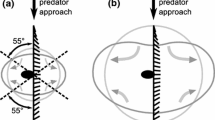Abstract
The three-dimensional potential flow field of an oscillating sphere near a fish with an axially symmetric body was investigated mathematically. The spatial distributions of the stimuli to the lateral line system are derived from the flow-field analysis, taking into consideration the hydrodynamical interaction between the fish body and the flow of the oscillating sphere. This was done dependent on the location and the direction of oscillation of the sphere relative to the fish. The theoretical results are compared with measurements of the flow on the surface of a fish model.
Similar content being viewed by others
References
Abdel-Latif H, Hassan ES, Campenhausen C von (1990) Sensory performance of blind Mexican cave fish after destruction of the canal neuromasts. Naturwissenschaften 77:237–239
Coombs S, Janssen J (1989) Peripheral processing by the lateral line system of the mottled sculpin (Cottus bairdi). In: Coombs S, Görner P, Münz H (eds) The mechanosensory lateral line. Springer, Berlin Heidelberg New York, pp. 299–319
Coombs S, Janssen J (1990) Behavioral and neurophysiological assessment of lateral line sensitivity in the mottled sculpin,Cottus bairdi. J Comp Physiol 167:557–567
Denton EJ, Gray JAB (1982) The rigidity of fish and patterns of lateral line stimulation. Nature 297:679–681
Denton EJ, Gray JAB (1983) Mechanical factors in the excitation of clupeid lateral lines. Proc R Soc Lond [Biol] 218:1–26
Denton EJ, Gray JAB (1989) Some observation on the forces acting on neuromasts in fish lateral line canals. In Coombs S, Görner P, Münz H (eds) The mechanosensory lateral line: neurobiology and evolution. Springer, Berlin Heidelberg New York, pp 229–246
Enger PS, Kalmijn AJ, Sand O (1989) Behavioral investigation on the functions of the lateral line and inner ear in predation. In: Coombs S, Görner P, Münz H (eds) The mechanosensory lateral line. Springer, Berlin Heidelberg New York, pp 575–587
Frühbeis B (1984) Verhaltensphysiologische Untersuchungen zur Frequenzunterscheidung and Empfindlichkeit durch das Seitenlinienorgan des blinden HöhlenfischesAnoptichthys jordani (Hubbs et Innes). Dissertation, University of Mainz
Geer JF (1975) Uniform asymptotic solutions for potential flow about a slender body of revolution. J Fluid Mech 67:817–827
Handelsman RA, Keller JB (1967) Axially symmetric potential flow around a slender body. J Fluid Mech 28:131–147
Harris GG, Bergeijk WA van (1962) Evidence that the lateral-line organ responds to near-field displacements of sound sources in water. J Acoust Soc Am 34:1831–1841
Hassan ES (1985) A suggested role for secondary flow in the stimulation of the cochlear hair cell. Biol Cybern 53:109–119
Hassan ES (1992a) Mathematical description of the stimuli to the lateral line system of fish derived from a three-dimensional flow field analysis. I. The cases of moving in open water and of gliding towards a plane surface. Biol Cybern 66:443–452
Hassan ES (1992b) Mathematical description of the stimuli to the lateral line system of fish derived from a three-dimensional flow field analysis. II. The case of gliding alongside or above a plane surface. Biol Cybern 66:443–452
Hassan ES, Abdel-Latif H, Biebricher R (1992) Studies on the effects of Ca++ and Co++ on the swimming behavior of the blind Mexican cave fish. J Comp Physiol 171:413–419
Kalmijn AJ (1988) Hydrodynamic and acoustic field detection. In: Atema J, Fay RR, Popper AN, Tavolga WN (eds) Sensory biology of aquatic animals. Springer, Berlin Heidelberg New York, pp 83–110
Karlsen HE, Sand O (1987) Selective and reversible blocking of the lateral line in freshwater fish. J Exp Biol 133:249–262
Kroese ABA, Schellart (1987) Evidence for velocity-and acceleration-sensitive units in the trunk lateral line of the trout. J Physiol 394:13
Kroese ABA, Zalm JM van der, Bercken J van der (1978) Frequency response of the lateral-line organ ofXenopus laevis. Pflugers Arch 375:167–175
Lamb H (1931) Lehrbuch der Hydrodynamik, 2nd edn. Teubner, Leipzig Berlin, pp 132–133
Münz H, Class B, Fritzsch B (1984) Electroreceptive and mechanoreceptive units in the lateral line of the axolotlAmbystoma mexicanum. J. Comp Physiol 154:33–44
Netten SM van (1991) Hydrodynamics of the excitation of the cupula in the fish canal lateral line. J Acoust Soc Am 89:310–319
Sand O, Ozawa S, Hagiwara S (1975) Electrical and mechanical stimulation of hair cells in the mudpuppy. J Comp Physiol 102:13–26
Saunders AJ, Montgomery JC (1985) Field and laboratory studies of the feeding behavior of the piperHyporhamphus ihi with reference to the role of the lateral line in feeding. Proc R Soc Lond [Biol] 224:209–221
Schlichting H (1982) Grenzschicht Theorie. Braun, Karlsruhe
Webb JF (1989) Development constraints and evolution of the lateral line system in teleost fishes. In: Coombs S, Görner P, Münz H (eds) The mechanosensory lateral line. Springer, Berlin Heidelberg New York, pp 79–98
Author information
Authors and Affiliations
Rights and permissions
About this article
Cite this article
Hassan, ES. Mathematical description of the stimuli to the lateral line system of fish, derived from a three-dimensional flow field analysis. III. The case of an oscillating sphere near the fish. Biol. Cybern. 69, 525–538 (1993). https://doi.org/10.1007/BF01185424
Received:
Accepted:
Issue Date:
DOI: https://doi.org/10.1007/BF01185424




